In this modern age, posting letters and cards is less common than ever before, but it’s still very much a part of life in France – a nation renowned for its love of paperwork and bureaucracy!
Like all things in a new culture, there are some things to get used to when it comes to letter-writing French-style.
Dear Who?
Typically, a letter will have your name and address in the top left hand side, and the date and addressee details aligned lower down to the right.
Unless you are writing to a personal friend, your letter should always use the formal conjugations of “vous” instead of “tu” – if you’re not sure what this is, you can check all French verb tables here: http://www.conjugaison.com/
The French word “cher” is the equivalent of the English “dear.” You can say “Cher Monsieur” for a man, or “Chère Madame” for a female addressee. If you are writing to more than one person, you can say “Chers Messieurs et Mesdames” – which means “Dear Sirs and Madams.”
You would not use first name terms unless writing to a friend. In a formal letter you should address the person by their name or official title. If you don’t know the name(s) of the recipients – use “Monsieur le Directeur” or “Madame la Directrice” or you are writing to a group, you could use “À qui de droit,” ie “To whom it may concern.”
The top section of a letter will look something like this:
Yours sincerely
Why use 2 words when at least 10 will do?! The French are a lot more formal when it comes to closing a letter. Typically for professional correspondence the English phrase “Yours sincerely” or “Yours faithfully” will be “Je vous prie d’agréer, Monsieur/Madame (or whichever title you used in the top of the letter) l’expression de mes salutations distinguées.”
That’s quite a mouthful – but it’s written all the time, so make a note and keep it handy!
Addresses and Envelopes
Yes, like letters, addressing an envelope has its own rules in France. For starters, addresses should not be any longer than six lines (seven for international), with no more than 38 characters per line, and CAPITAL LETTERS ARE USED – a lot.
The three core details of any French address are the recipient/addressee or “destinataire”, the street address, and the postcode + locality/town. These are the 3 lines that will be in every address. Additional information is often used to add special details or clarity to the delivery instructions.
On the envelope the address should be placed on the bottom right hand section in the following order – essential items are in bold
Line 1: Name, title, and other pleasantries
Line 2: Secondary address information (apartment number, etc.) optional
Line 3: Information regarding access (building name, entrance number/location, etc.) optional
Line 4: Street name and number
Line 5: Additional information for aiding in delivery (PO box, lieu-dit, etc.) optional
Line 6: Postal code and name of city or other applicable locality
Line 7: Country of destination—optional (only necessary for international mail)
A typical envelope will be written as below, note that almost all essential items, proper nouns surnames or business names are in CAPITALS, it is only the supplementary information in lower case. If the address is a business, the company name will be on Line 1 and the addressee moves to Line 2.
Postal Codes
A French postal code is five digits consisting solely of numbers; no letters, no spaces, no hyphens (similar to a US ZIP Code). There are over 30,000 officially recognized postal codes in France and you will find them listed here: https://www.laposte.fr/particulier/outils/trouver-un-code-postal
A postal code is based on French “départements”—administrative subdivisions of a larger “région” (the equivalent of a county, to an English speaker).
The first two postal code numbers match the number of the département where you can find the destination city (ie 34 for anywhere in Hérault). The other three numbers in the code indicate which post office will actually handle the job of delivering the letter.
Most French postcodes end in a zero (exceptions include some major cities, overseas territories, and post office boxes).
What’s a CEDEX?
“CEDEX” is an abbreviation of Courrier d’Entreprise à Distribution EXceptionnelle (special business mail). This will apply to organisations which receive huge quantities of mail, and where an individualized postcode is given. Sometimes you will see CEDEX also with a number; which will apply in case a city has multiple post offices.
So to complicate things a little further, CEDEX addresses are addresses with their own postal code, usually with a PO Box as well ie:
The PO box number—preceded by the letters “BP” for “Boîte Postale”, will either take a line of its own, or precede the town, depending where the postbox is situated. The word “CEDEX” is added last, after the locality of the post office and town.
Another accepted abbreviation is shortening “Saint” and “Sainte” to “ST” and “STE” (also in capitals), respectively.
So having completed the mission of addressing your envelope correctly – you will then write your own address as the sender (“expéditeur”) on the reverse over the sealed portion of the envelope, to show that it has not been opened or tampered with, like so:
Copy copy copy
Important tip – keep at least one copy of everything! With so much paperwork to be handled, it is not unheard of that correspondence or complete dossiers can disappear in the wonderland of a French administration center…
So how long should you keep your mail and copies? Any paperwork relating to income and tax should be kept safely for 10 years.
Posting the Letter
If it’s a regular letter, chances are you’ll be sending it via La Poste, which also provides banking services under the banner of La Banque Postale. La Poste provides all manner of financial services, as well as insurance, mobile phone contracts, mail forwarding (“faire suivre”), mail holding (“garde du courrier”), verified identity for administrative issues (“Identité Numérique“) and a surprising number of community services such as checking on elderly relatives. La Poste is a national institution and almost as central to French daily life as la boulangerie!
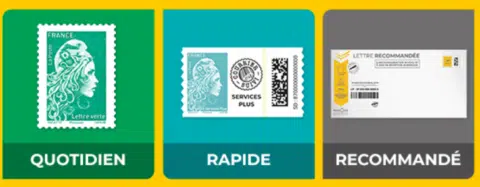
Photo from La Poste
Ways of sending a letter in 2023
Officially called Marianne stamps (“timbres Marianne”) French stamps are printed with the face of Marianne, the personification of the Republic of France.
La Poste has modified its stamps and ways to send a letter on the first of January 2023. Thefore, the red stamp (“timbre rouge”), purple stamp (“timbre violet“) and gray stamp (“Ecopli“) no longer exist. However, you can still send letter with the old stamps but it may take a day longer than it used to before.
The green stamp (“timbre vert”) is for slightly slower service, generally two to three days. Green is a more eco-friendly alternative, and reportedly produces 15% less CO2 than first class.
The Lettre Services Plus is sent in two days, includes a tracking and can be picked up by the postman in your mailbox.
The E-Lettre Rouge allows you to write your letter online, which will be sent to La Poste and sent physically by the post services the following day.
Prices to send a letter in 2023
Lettre Services Plus: starts at 2.86€
Lettre Verte: starts at 1.13€
E-Lettre Rouge: starts at 1.49€
Conveniently, you can also purchase packs of 12 preprinted green ‘stamped’ envelopes in post offices and supermarkets. Even more convenient, now you can print your own stamps (and personalize them!) and have you letters picked up in your mailbox, which is cheaper than going to the nearest poste, without even having to go out! If you don’t have a printer, there are printers available in posts office.
Tracked mail and parcels
Adding “sticker suivi” for 0.50€ allows simple tracking of a letter sent in France. Express services like Chronopost and Colissimo (tracked parcels), allow tracking in France and internationally. Registered Letter with Receipt of Delivery (“Lettre Recommandée Avec Accusé de Réception (AR)”*) is a recorded delivery service for many countries within Europe and a confirmation receipt will be received by the sender, or confirmation of delivery can be obtained online. General delivery time is three days and you will need to fill out the required forms at the post office. When your letter is received, the recipient will sign for it and the signed receipt (“avis de réception”) will be returned to you through the mail. Pricing is dependent on the weight and value of the item you are sending, and insurance is optional.
New in 2023: you can now send your Lettre Recommandée Avec Accusé de Réception (AR) from your phone or computer. La Poste will take care of printing and distributing it immediatly. The accusé de réception (proof of delivery) will be signed electronically and available instantly as a PDF.
*This is how we recommend that all official documents should be sent within France.
You’ve got mail?!
If you’re struggling with translation or need help writing or understanding an official letter, please contact us – we have a network of French and English speaking lawyers, accountants and notaires, and we’re here to help!
Useful links (in French)
All option available: https://www.laposte.fr/nouvelle-gamme-courrier
Print your stamps: https://www.laposte.fr/mon-timbre-en-ligne
Stamps pricing: https://www.laposte.fr/mon-timbre-en-ligne/tarifs
Sending a Lettre Recommandée: https://www.laposte.fr/envoyer/envoi-courrier-lettre-recommandee
You might also be interested in…
Dennelle is the President of Renestance and a bilingual American who’s lived in France since 2000. She loves so many things about France, its language, culture, geography, quality of life... that she started a business to help others realize their dreams of living in this incredible place.
All articles by: Dennelle Taylor Nizoux

![Sending a Letter in France [Updated for 2023]](https://www.renestance.com/wp-content/uploads/2020/11/france-1256522_1920-1080x675.jpg.webp)
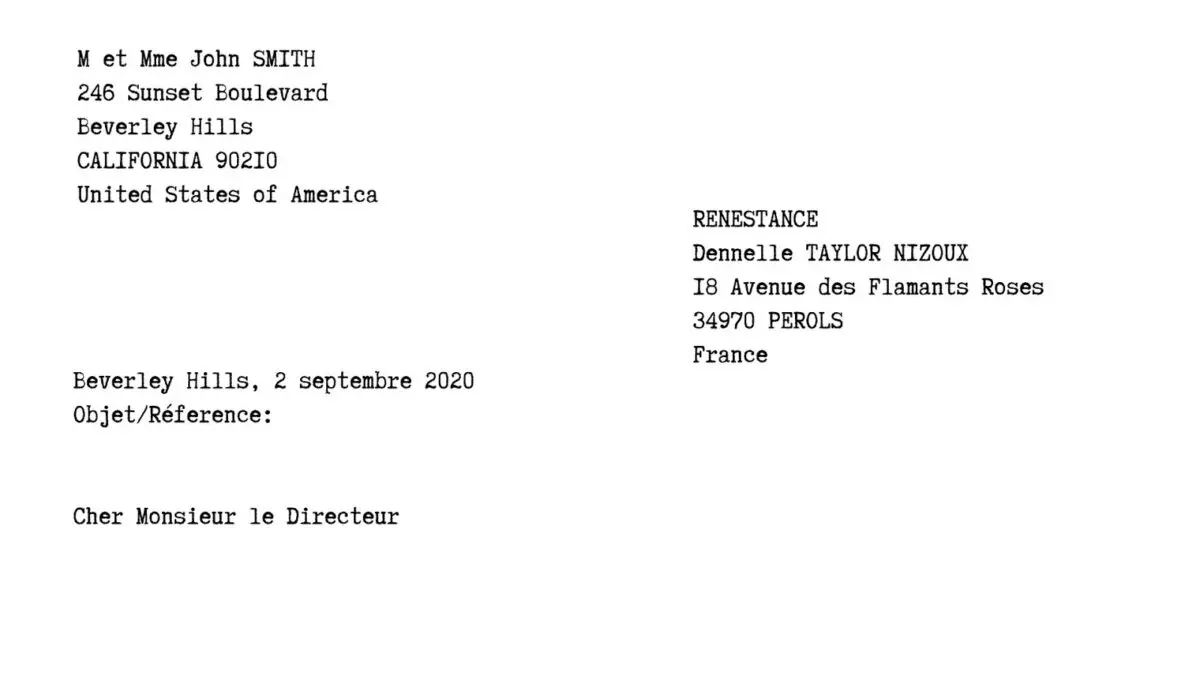

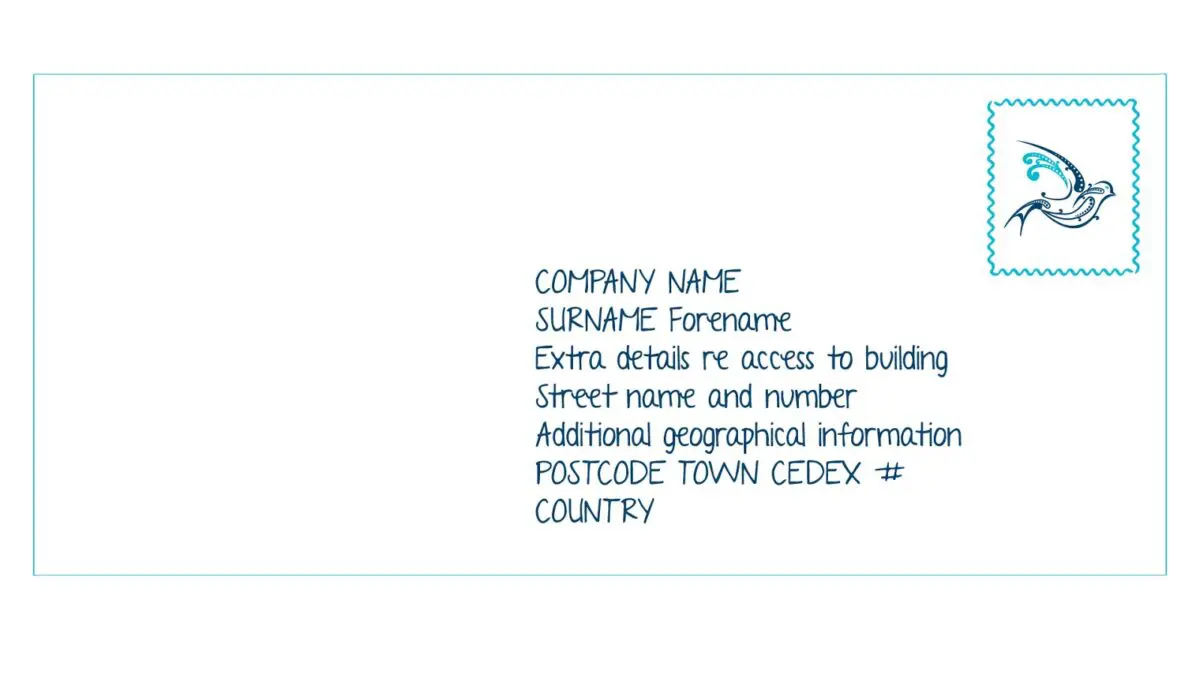
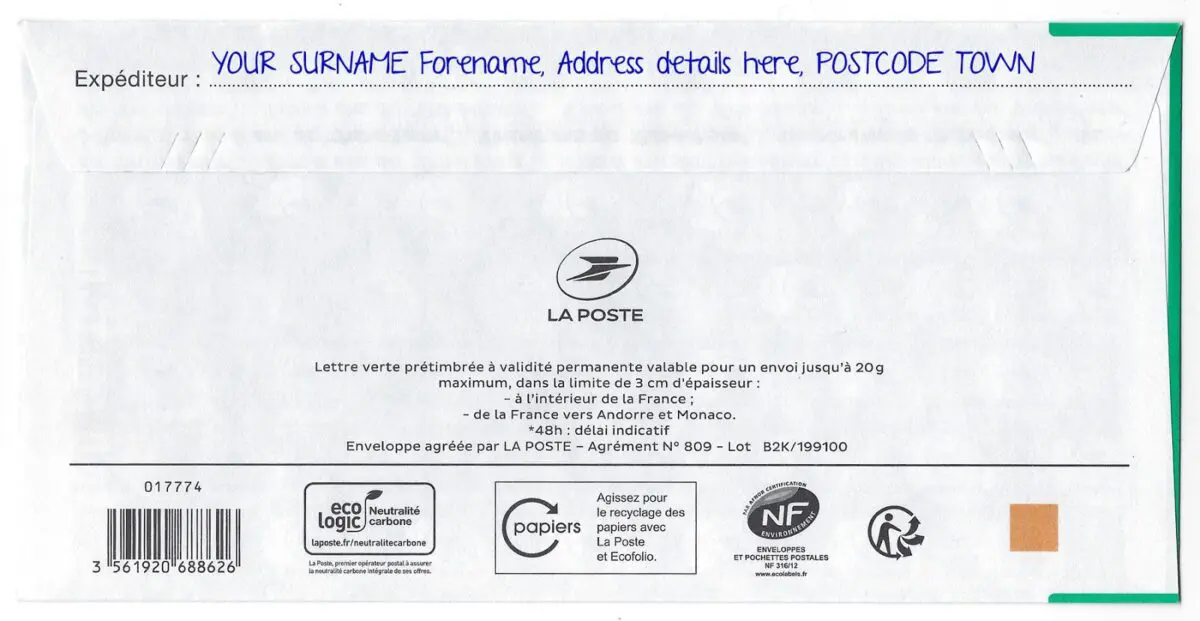
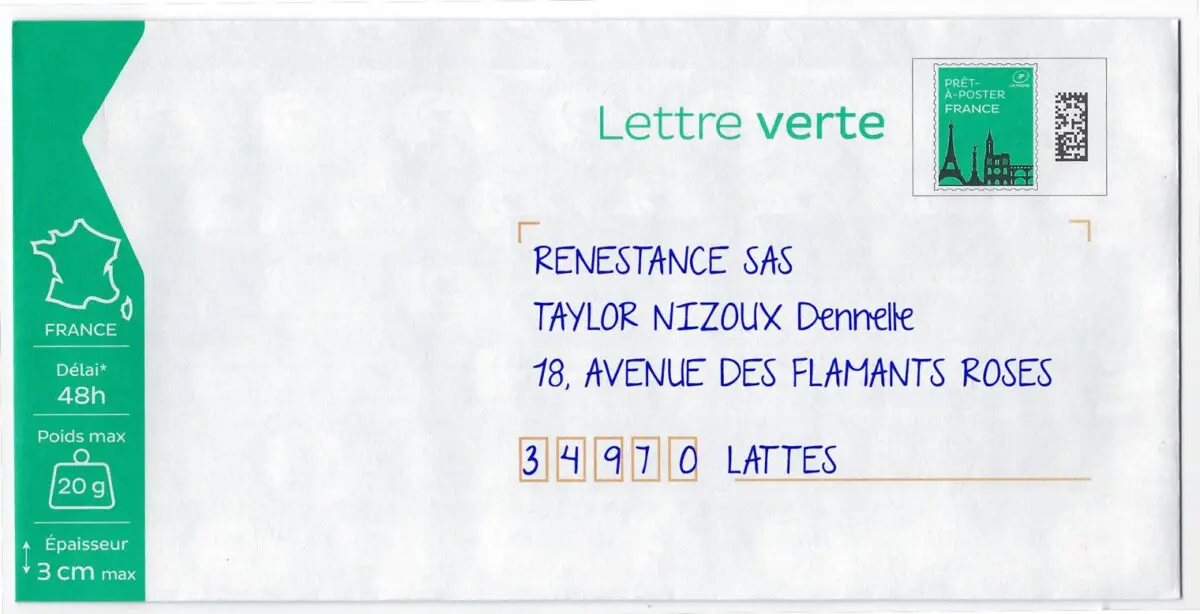



Ron Groves
on 2020-12-01 at 22:14Chère Madame Dennelle Taylor Nizoux, Président de Renestance
Thank you so much for your article about Sending a Letter in France. Our move to Nîmes was stopped at the last minute by the pandemic. Though our initial move may be to Nîmes, it may not be our final move. We keep up with all we can through our forum “liveinfrance”, the local digital journals and, of course, your newsletters. We hope to some day meet personally sometime after we arrive in France (hopefully upon getting the vaccination).
Je vous prie d’agréer, Madame Dennelle Taylor Nizoux, Président de Renestance, l’expression de mes salutations distinguées,
Ron Groves,
Major (USAF Retired)
IBM, Resource Deployment Mgr. (Retired)
5 Elderwood
Irvine, California
92614 USA
P.S. I hope my formal salutation and signature is correct.
Très bien, Monsieur Groves! Vous avez tout compris! Yes, we are anxiously awaiting the green light for all our readers and clients stuck in the USA to finally begin their French dreams. Fingers crossed for early in the New Year. This practice in patience will serve you well once in France! 😉 Please stay safe in the meantime. Kind regards, Dennelle